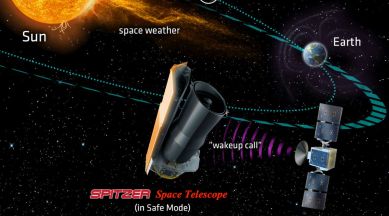Groundbreaking proposal sets out to resurrect NASA’s Spitzer Telescope
The Spitzer Resurrection Mission will send a telerobotic space probe to bring the Spitzer space telescope back to life.

Although most people may be familiar with the Hubble and the recent James Webb Space Telescope, many lesser-known NASA telescopes have made crucial contributions to our understanding of the universe. The Spitzer Space Telescope is one of them.
Spitzer was the third space telescope that was dedicated to infrared imaging and was launched in 2003. While it was initially designed to function for a little longer than five years, Spitzer continued chugging along till January 2020, when it was retired. But now, a bold new proposal aims to bring the veteran space telescope back to life.
The Spitzer telescope went well past its designated lifespan and continued to work on its mission for more than 16 years. The satellite telescope orbits the Sun about one astronomical unit (AU) in an Earth-trailing orbit. Right now, the telescope is about two AU away from the planet. An AU is 149.6 million kilometres, the mean distance between the center of the Earth and the centre of the Sun.
In its current location, direct communications with Earth are not possible. NASA decided to retire the telescope in 2020 by placing it in safe mode in response to this challenging orbit, according to Rhea Space Activity.
The Spitzer Resurrector mission is designed to “restart” the telescope. It will confirm that Spitzer has been restored to its original performance capabilities. After that, it will remain near the telescope to act as a high-rate data relay to our planet. This can restore Spitzer to its full efficiency. The telerobotic Spitzer-Resurrector spacecraft would travel around 300 million kilometres to the telescope to restore its service.
“The ISAM implications of resurrecting Spitzer are jaw dropping. This would be the most complex robotic mission ever performed by humanity. As a teenager in the 1990s I watched U.S. astronauts repair the first Great Observatory, the Hubble Space Telescope (HST), and now Rhea Space Activity has been given the opportunity to telerobotically extend the life of the last Great Observatory, the Spitzer Space Telescope,” said Shawn Usman, CEO of Rhea Space Activity, in a press statement.
After it is “resurrected” in this fashion, the telescope will be used to detect and characterise Near Earth Objects, which are potentially hazardous. Scientists will also be able to continue using Spitzer for other astronomical observations.